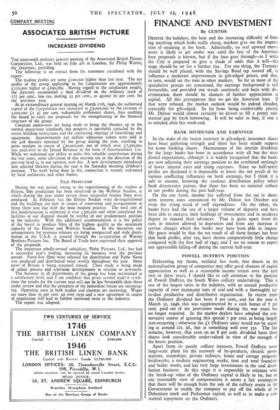FINANCE AND INVESTMENT
By CUSTOS
DESPITE the holidays, the heat and the increasing difficulty of find- ing anything which looks really cheap, markets give me the impres- sion of straining at the leash. Admittedly, no real upward move- ment is likely to get under way until the fate of the American loan proposals is known, but if the loan goes throughâas I write the City is prepared to give a shade of odds that it willâthe stage should be set for a further rise. For one thing, the Treasury should be well placed, with the Savings Bond tap turned off, to influence a moderate improvement in gilt-edged prices, and that, in turn, would set the tone in other markets_ So far as most of the speculative groups are .concerned, the earnings background is still favourable, and provided one treads cautiously and buys with dis- crimination ...there should be chances of further appreciation of capital. All this presupposes that we get the American loan. If that were refused, the market outlook would be indeed clouded, especially for gilt-edged. So far from being comfortably placed, Mr. Dalton would alrriost certainly be driven to fill a pretty sub- stantial gap by fresh borrowing. It will be safer to buy, if one is so minded, after this week-end.
BANK DIVIDENDS AND EARNINGS
In the wake of the recent recovery in gilt-edged, insurance shares have been gathering strength and there has been steady support for home banking shares. Maintenance of the interim dividends by the large banks has been in accordance with all but the most dismal expectations, although it is widely recognised that the banks are now adjusting their earnings position to the combined onslaught of lower interest rates and rising expenses. Since no half-yearly profits are disclosed it is impossible to know the net result of the various conflicting influences on bank earnings, but I think it is safe to assume, knowing the cautious distribution policy which bank directorates pursue, that there has been no material setback in net profits during the past half-year.
On the one hand, income has suffered from the cut in short- term interest rates announced by Mr. Dalton last October and from the rising trend of staff expenditure. On the other, the banks have had the use of a larger volume of deposits and have been able to increase their holdings of investments and in moderate degree to expand their advances. That is quite apart from the cuts in interest allowed to depositors and from any increase in service charges which the banks may have been able to impose. My guess would be that the net result of all these factors has been that bank profits, after tax, have shown comparatively little change compared with the first half of 1945, and I see no reason to expect
any appreciable falling-off during the current half-year. .
POWELL DUFFRYN POSITION
Elaborating my theme, outlined last week, that shares in the nationalisation group of companies may offer good chances of capital appreciation as well as a reasonable income return over the next two or three years, I should like to call attention to the position of Powell Duffryn, the South Wales colliery undertaking. This is one of the largest units in the industry, with an annual productive capacity of over 20,000,000 tons of coal and with a thoroughly up- to-date productive and distributive organisation. In recent years the Ordinary dividend has been 8 per centâ and for the year to March 31, 1946, this was supplemented by a cash bonus of 7 per cent. paid out of tax provisions made during the war years but no longer required. In the market dealers have adopted the con- servative course of ignoring this special 7 per cent. as being largely non-recurring ; otherwise the £i Ordinary units would not be stand- ing at around 22s. 3d., but at something well over 35s. The fact remains, however, that even on an 8 per cent. dividend basis these shares look considerably under-valued in view of the strength of the 'Assets position.
Apart from its purely colliery interests, Powell Duffryn ri owns th large-scale plant for the recovery of by-products, electric power stations, steamships, private railways, house and cottage property, brickworks, a modern engineering works, iron and steel foundries and boiler works, and has very large investments in the coal distri- bution business. At this stage it is impossible to estimate what the break-up value of the Ordinary capital is likely to be, ,but on any reasonable- view of compensation it seems a fair assumption that there will be enough from the sale of the colliery assets to the Government to enable the company to pay off the whole of its Debenture stock and Preference capital, as well as to make a sub- stantial repayment on- the Ordinary.






























 Previous page
Previous page